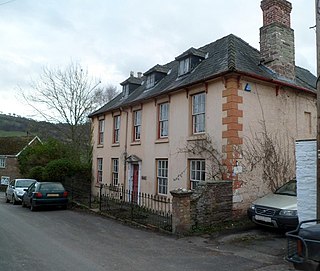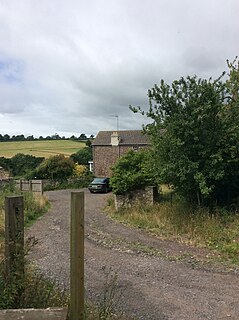
LlanvihangelCourt, Llanvihangel Crucorney, is a Tudor country house in Monmouthshire, Wales. The architectural historian John Newman, in his Gwent/Monmouthshire volume of The Buildings of Wales series described the court as "the most impressive and richly decorated house of around 1600 in Monmouthshire". The origins of the house are medieval, with a traditional date of construction of 1471. The building was given its present appearance by a substantial enlargement and re-casing of circa 1600 by Rhys Morgan, of the family of the original owners. In the very early 17th century it was owned briefly by Edward Somerset, 4th Earl of Worcester.

Pant-y-Goitre Bridge crosses the River Usk between Abergavenny and Usk near the village of Llanfair Kilgeddin. The bridge carries the B4598. It was constructed in 1821 by the engineer John Upton.

Glyndŵr House, Grosmont, Monmouthshire is a village house dating from the late 17th century. It is a Grade II* listed building.

Town Farm, Grosmont, Monmouthshire is a farmhouse dating from the 17th century. It is a Grade II* listed building.

Tŷ Mawr, Dingestow, Monmouthshire is a complex of farm buildings dating from 1640. The farmhouse and attached barn are listed Grade II*. The gatehouse to the farm has a separate Grade II* listing.

The Tabernacle Baptist Chapel, Ffwthog, near Cwmyoy, Monmouthshire is a Baptist chapel, with attached manse, dating from 1837. Largely unaltered externally and internally, the chapel is a Grade II* listed building.

The Church of St Teilo, Llanarth, Monmouthshire, Wales is a former parish church with its origins in the 15th century. Renovations took place in the 18th, 19th and 20th centuries. It is a Grade II* listed building and is now a redundant church, having closed in 2013.

The Church of St Peter, Bryngwyn, Monmouthshire, Wales is a parish church with its origins in the 13th century. It is a Grade II* listed building.

27 Old Market Street, Usk, Monmouthshire, forms part of a range of terraced houses which were originally the Great House of Roger Williams, High Sheriff of Monmouthshire in the mid-16th century. It is a Grade II* listed building.

Porth-y-carn, Porthycarne Street, Usk, Monmouthshire is an early 19th-century Neoclassical villa. Built c. 1834 for Thomas Reece, the agent of the "iron king", Crawshay Bailey, it is a Grade II* listed building.

The Church of St Michael, Llanvihangel Gobion, Monmouthshire is a parish church with datable origins to the 15th century. There is no record of a Victorian restoration, although one must have occurred, but there is documented evidence of a "light" reconstruction in 1925. Since the date, the church has barely been altered. It remains an active parish church and a Grade II* listed building.

The Church of St Madoc, Llanbadoc, Monmouthshire is a parish church with its origins in the 14th century. A Grade II* listed building, the church remains an active parish church.

Ty-mawr Farmhouse, Ffwthog, Cwmyoy, Monmouthshire is a farmhouse dating from the early 16th century, which was extended in the 17th century and then reduced in size in the 18th century. The farmhouse is a Grade II* listed building, with its range of barns and its bee shelter having separate Grade II listed building designations.

The White Hart Inn, Llangybi, Monmouthshire is an inn dating from the early 17th century. Located at the a crossroads in the centre of the village, it is a Grade II* listed building.

Ty Uchaf Farmhouse, Llanelly, Monmouthshire is a farmhouse in the west of the county dating from the early 17th century. Located 0.5km north-west of the Church of St Elli, it is a Grade II* listed building.

Lower Dyffryn House, Grosmont, Monmouthshire is a farmhouse dating from the 16th century. Owned by a Sheriff of Monmouthshire in the early 1600s, it was rebuilt by the Cecil family in the mid 17th century as a substantial mansion to the typical Elizabethan e-plan. Its fortunes declined in the 19th century by which point it had been reduced to a farmhouse and much of its external and internal fittings were removed or replaced. The farmhouse is Grade II* listed and a number of the ancillary buildings have their own Grade II listings.

Howick Farmhouse, in the hamlet of Howick, near Itton, Monmouthshire is a farmhouse dating from the mid-16th century. It is a Grade II* listed building. Its associated barns and stable block have their own Grade II listings.

Newhouse Farmhouse, Llanvetherine, Monmouthshire is a farmhouse dating from the late-16th century. It is a Grade II* listed building. Its associated barns and stable block have their own Grade II listings.

Pentwyn, Llanllowell, Monmouthshire is a farmhouse dating from the mid-16th century. The house is Grade II* listed, with the adjacent barn having its own Grade II listing.

Cwm Bwchel Farmhouse, Llanthony, Monmouthshire is a farmhouse dating from the late-Medieval period. It carries a date stone of 1694, which probably refers to a period of reconstruction. The farmhouse is Grade II* listed and a number of the ancillary buildings on the farmstead have their own Grade II listings.





















